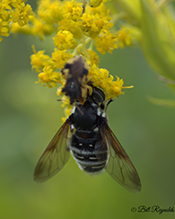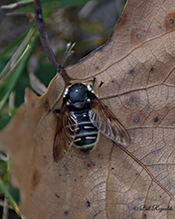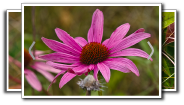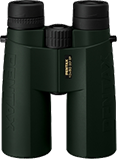Bald-faced hornet fly
(Spilomyia fusca)
Conservation • Description • Habitat • Ecology • Distribution • Taxonomy
Conservation Status |
|||
| IUCN Red List | not listed |
||
| NatureServe | NNR - Unranked |
||
| Minnesota | not listed |
||
Description |
Bald-faced hornet fly is a fairly common, medium-sized to large, wasp-mimicking, flower fly. It occurs in the United States from Maine to Pennsylvania, west to Minnesota and Indiana, and south along the Appalachian Mountains to northern Georgia. It occurs in southern Canada from Nova Scotia to Manitoba. Adults are active from mid-June to early September. They are found in woodland openings and at the edges of woodlands, especially near swampy areas. In Europe, Spilomyia larvae have been found in a tree hole. Little else is known of the biology of any Spilomyia species. Spilomyia fusca has been recorded on goldenrod, Joe-pye weed, pearly everlasting, and meadowsweet. Bald-faced hornet fly is an impressive mimic of the bald-faced hornet both in appearance and in behavior. Adults are 9⁄16″ to 11⁄16″ (14.6 to 18.1 mm) in length. The color of the light markings on the head and body is somewhat variable, pure white, almost white, pale yellow, or yellow. On most individuals, all of the markings are white except for the band on the rear margin of the scutellum, which is always yellow. Many individuals show at least some pale yellow. Few individuals have all yellow markings. The head is hemispherical and wider than the thorax. When viewed from the side, the face is nearly straight, not concave. The lateral parts of the head (gena), equivalent to the cheeks, are white. A black line separates the face and gena. The antennae are black and short. They have three segments. The third segment has a large, brownish-yellow bristle (arista) on the upper side. The arista is bare, not feather-like (plumose). The tube-like protruding mouthpart (proboscis) is short and fleshy. There are two large compound eyes on the sides of the head and three small simple eyes (ocelli) in a triangle on the top of the head. The compound eyes are dark brown with irregular, vertical, white bands and rows of spots which help to disguise the large eyes. On the male the compound eyes meet at the top of the head. On the female they do not meet, and the black lines between the face and gena taper and converge approaching the ocelli, becoming a single thin brown line at the front ocellus. The thorax is black with white markings. The large exoskeletal plate (scutum) covering the middle segment of the thorax has two pairs of white spots on the front margin, a white line on each side from the rear margin that bends inward at the transverse suture, and a pair of oblique white lines at the rear margin that form an inverted v. The small plate between the thorax and the abdomen (scutellum) is black with a narrow yellow band on the rear margin. The abdomen has four segments, and each segment is covered by a hardened exoskeletal plate (tergite). Tergites 1 and 2 (T1 and T2) are entirely black. This is the only Spilomyia species with T2 entirely black. T3 is black with a white spot on each lateral margin at the middle and a white band on the rear margin. T4 has a white band on the front margin that is narrowly interrupted in the middle, and a band on the rear margin that is complete, not interrupted. The wings are mostly clear, but the front third is darkened. There is a spurious vein between the radius (R) and media (M) veins. The cross-vein that runs between the R and M veins is strongly oblique. The anal cell is long and is closed near the wing margin. The R5 and M2 cells are also closed. The radial sector vein (Rs) has 2 branches. The legs are mostly yellow. The third segment (femur) of the hind leg is at least half black and has an unbranched spur near but not at the tip. The fourth segment (tibia) of the front leg is mostly black, white just at the tip. On the middle legs, the tibia is white on the basal half, brown toward the tip. On the rear legs it is mostly white, black just at the tip. The last part of the leg (tarsus), corresponding to the foot, has 5 segments. It is black on the front legs, brownish white on the middle legs, and brown on the hind legs. |
Size |
Total length: 9⁄16″ to 11⁄16″ (14.6 to 18.1 mm) |
Similar Species |
Habitat |
|
Ecology |
Season |
Mid-June to early September |
Behavior |
Adults have short antennae, but they will mimic wasps by extending and vibrating their front legs. Males engage in “hilltopping” to find a mate. In the morning, they fly to the most prominent hilltop, or in a flat area to a low rise. Hilltopping behavior ends soon after noon. |
Life Cycle |
|
Larva Food |
|
Adult Food |
Pollen and nectar of plants whose flowers produce large amounts of pollen, including goldenrod, Joe-pye weed, pearly everlasting, and meadowsweet. |
Distribution |
||
|
Sources Telford, Horace S.. (1939). The Syrphidae of Minnesota. University of Minnesota. Minnesota Agricultural Experiment Station. |
|
| 9/14/2025 | ||
Occurrence |
||
|
||
Taxonomy |
|
Order |
|
Suborder |
Brachycera |
Infraorder |
Cyclorrhapha |
Zoosection |
Aschiza |
Family |
Syrphidae (Hover Flies) |
Subfamily |
Eristalinae (drone flies and allies) |
Tribe |
Milesiini |
Subtribe |
Milesiina |
Genus |
Spilomyia (hornet flies) |
Subordinate Taxa |
|
|
|
Synonyms |
|
Milesia analis |
|
Common Names |
|
bald-faced hornet fly |
|
Glossary
Arista
A large bristle on the upper side of the third segment of the antenna of a fly. Plural: aristae.
Femur
On insects and arachnids, the third, largest, most robust segment of the leg, coming immediately before the tibia. On humans, the thigh bone.
Gena
In insects: The area between the compound eye and the mandible; the cheek. In birds: The area between the the angle of the jaw and the bill; the feathered side (outside) of the under mandible. Plural: genae.
Ocellus
Simple eye; an eye with a single lens. Plural: ocelli.
Plumose
Feathery; having fine, pinnately arranged, lateral bristles or hairs arranged on both sides of an axis.
Scutellum
The exoskeletal plate covering the rearward (posterior) part of the middle segment of the thorax in some insects. In Coleoptera, Hemiptera, and Homoptera, the dorsal, often triangular plate behind the pronotum and between the bases of the front wings. In Diptera, the exoskeletal plate between the abdomen and the thorax.
Scutum
The forward (anterior) portion of the middle segment of the thorax (mesonotum) in insects and some arachnids.
Tarsus
On insects, the last two to five subdivisions of the leg, attached to the tibia; the foot. On spiders, the last segment of the leg. Plural: tarsi.
Tergite
The upper (dorsal), hardened plate on a segment of the thorax or abdomen of an arthropod or myriapod.
Tibia
The fourth segment of an insect leg, after the femur and before the tarsus (foot). The fifth segment of a spider leg or palp. Plural: tibiae.
Visitor Photos
Share your photo of this insect.
This button not working for you?
Simply email us at info@MinnesotaSeasons.com.
Attach one or more photos and, if you like, a caption.
Bill Reynolds |
||
A mimic and an ambush! A Jagged Ambush bug caught itself a Bald-faced Hornet fly. A bit windy today, so I was struggling to get a good image. I coaxed the fly away from the Ambush bug, it keeping the head, to verified I was looking at a mimic or the real thing. |
||
 |
 |
|
 |
||
Alfredo Colon |
||
Spectacular Fly Bald-faced Hornet Fly, Spilomyia fusca |
||
 |
 |
|
 |
||
MinnesotaSeasons.com Photos
|

Slideshows
Spilomyia fusca
larry522

Visitor Videos
Share your video of this insect.
This button not working for you?
Simply email us at info@MinnesotaSeasons.com.
Attach a video, a YouTube link, or a cloud storage link.
Other Videos
Behavioural mimicry in the hover fly Spilomyia fusca (by Henri Goulet)
Chris Hassall
Spilomyia fusca
René Ammann
Spilomyia fusca
Bombus mystax
Bald Faced Hornet Fly Spilomyia fusca
Useful Knowledge📖 & Awesome Creatures🐯

Visitor Sightings
Report a sighting of this insect.
This button not working for you?
Simply email us at info@MinnesotaSeasons.com.
Be sure to include a location.
Bill Reynolds
9/13/2025
Location: Numedal TWP, Pennington Co MN
A Jagged Ambush bug caught itself a Bald-faced Hornet fly. A bit windy today, so I was struggling to get a good image. I coaxed the fly away from the Ambush bug, it keeping the head, to verified I was looking at a mimic or the real thing.
MinnesotaSeasons.com Sightings



